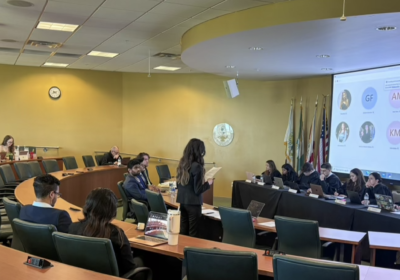Antarctic research breaks ice on biodrugs

SPECIAL TO THE ORACLE
Antarctic researchers from USF have received a federal grant that will allow them to return to the frozen tundra for another round of research and discovery.
USF’s chemistry department recently received a $1.7 million grant from the National Science Foundation to continue research in Antarctica, collecting organisms they say could hold the chemical key to treating diseases such as cancer.Bill Baker, USF chemistry professor and director of the Center for Drug Discovery and Innovation, has led this research for almost 24 years.
“The poles are a third of the globe and only 3 percent of the natural products have been reported because nobody wants to go scuba diving in Antarctica,” he said.
The first objective, Baker said, is to study the chemical interaction between the Antarctic environment and its organisms.
The chemicals researchers discover can be translated into natural medicine.
USF postdoctoral associate Ryan Young said the chemical compound Palmerolide A, discovered originally in the Antarctic, is extremely potent against skin cancer.
The Centers for Disease Control and Prevention reported 70,853 people in the U.S. were diagnosed with melanoma and 12,212 people in the U.S. died from it in 2011.
Labs could reproduce the chemicals to synthesize them as drugs for patients fighting diseases such as melanoma, malaria and Alzheimer’s.
Though much of the work is done in the lab, Baker said his team is thrilled to return to Antarctica and explore its marine frontier.
On their last trip, students and professors gathered samples in the sub-zero waters near the Palmer Station just off the Antarctic Peninsula.
When the weather permits, they dive in search of algae, sea sponges, crustaceans, sea slugs and other marine life.
Baker said studying in Antarctica has been and continues to be a magical experience, but it isn’t for the faint of heart.
Being far from his family has been the most difficult aspect for Baker. The natural environment, wildlife and diving also present many dangers.
“Diving is the primary danger,” he said “The extreme environment is not very forgiving. Any sort of equipment failure — it’s a dicey situation.”
The extreme cold of the water can cause ice crystals to form in the dive equipment; divers could find themselves without air in just moments. Diving through ice also means entering and exiting through a hole that can be more difficult to find than one may think.
Jacqueline Fries, a third year graduate student majoring in chemistry, said one of her many roles in assisting the research was being a dive tender who assisted divers while they collected samples.
“You have what is called brash ice that is completely packed in to the harbor that you have to try to maneuver a boat through,” she said. “Rougher days in the water could be a bit challenging to make sure you have the divers in safely.”
Fries said the weather was another challenge they faced.
“It turns on you,” she said. “A couple times, the wind would spike up and it became extremely windy when it wasn’t for hours before that.”
Despite the dangers of the project and being far from home, Jacqueline said she enjoyed the natural beauty of the Antarctic. Her favorite memory from the last trip was watching the fur seals play in the water.
“You get to appreciate it a little bit more since you’re only around about 35 people,” she said.
The new grant will be the longest to date, allowing three expeditions over four years to track experiments over a longer period.
The most significant part of the current research will be the ultra-high field nuclear magnetic resonance instrumentation. The device will allow researchers to study structures of compounds at an atomic level.
“What we were able to show is that, in fact, individuals at one site are all chemically the same, but these plants are different chemically from plants at another site,” Baker said. “What we don’t know is where the divide starts or stops.”
Baker said the new technology and discoveries that will be used on the trip will lead to a better understanding of the chemistry of marine invertebrates and hopefully produce pharmaceuticals that battle deadly diseases.






